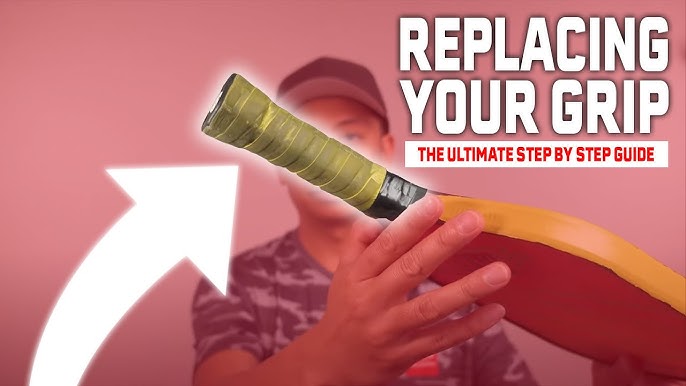To regrip a pickleball paddle, wrap tape around the grip, securing it to the paddle itself. Half of the tape should be on the paddle, while the other half should be on the grip.
This will ensure a secure grip on the paddle.
Gather The Necessary Materials
Before you start regripping your pickleball paddle, make sure you have all the necessary materials. Having everything prepared beforehand will ensure a smooth and efficient process. Here’s a list of what you’ll need:
Pickleball Paddle
First and foremost, you’ll need the pickleball paddle itself. Ensure it is clean and free from any dirt or debris before you begin the regripping process.
Grip Tape
Grip tape is an essential component for regriping a pickleball paddle. It provides a secure and comfortable grip, allowing you to maintain control during gameplay. Make sure to choose a grip tape specifically designed for pickleball paddles for the best results.
Grip Solvent Or Rubbing Alcohol
Grip solvent or rubbing alcohol is used to remove the old grip tape residue and clean the paddle handle. It helps ensure a clean and smooth surface for applying the new grip tape.
Scissors
Scissors are needed to trim the grip tape to the appropriate length. Make sure to use a sharp pair of scissors to achieve clean and precise cuts.
Finishing Tape
Finishing tape is the final step in the regripping process. It is used to secure the new grip tape in place, preventing it from unraveling and providing a neat and professional look. Electrical tape can also be used as an alternative if you don’t have finishing tape available.
Once you have gathered all the necessary materials, you’re ready to proceed with regripping your pickleball paddle. Follow the next steps to achieve a comfortable and secure grip for optimal gameplay.
Remove The Old Grip
Peel Off The Existing Grip Tape
Before you can regrip your pickleball paddle, the first step is to remove the old grip. Start by peeling off the existing grip tape, which is usually wrapped around the handle of the paddle. This can be done by carefully lifting the edge of the grip tape and slowly peeling it off in a smooth motion. Take your time to ensure that the grip tape comes off cleanly without leaving any residue behind.
Use Grip Solvent Or Rubbing Alcohol To Remove Any Residue
Once you have removed the grip tape, you may notice some residue or adhesive left on the paddle handle. To thoroughly clean the surface, it is recommended to use a grip solvent or rubbing alcohol. Apply a small amount of the solvent or alcohol onto a clean cloth or paper towel and gently rub the handle to remove any residue. This will ensure that the new grip adheres properly to the paddle handle.
Prepare The Paddle Handle For The New Grip
After removing any residue, it is important to prepare the paddle handle for the new grip. Make sure the handle is clean and dry before applying the new grip. This will provide a clean surface for the new grip to adhere to and ensure a secure and comfortable grip during your pickleball games.
Prepare The Paddle
htmlBefore you start regripping your pickleball paddle, it’s important to properly prepare the paddle handle. This ensures that the new grip will adhere well and last longer. Follow these steps to prepare your pickleball paddle:
1. Clean The Paddle Handle With Grip Solvent Or Rubbing Alcohol
Begin by cleaning the paddle handle using grip solvent or rubbing alcohol. Apply a few drops of grip solvent or rubbing alcohol onto a clean cloth and wipe down the handle, ensuring that you cover the entire surface. This removes any dirt, sweat, or old grip residue that may affect the adhesion of the new grip. Make sure to pay extra attention to any hard-to-reach areas or crevices on the handle.
2. Allow It To Dry Completely
After cleaning the handle, allow it to dry completely before applying the new grip. This step is crucial as moisture can interfere with the adhesion of the grip. Place the paddle in a well-ventilated area and let it air dry naturally. Ensure that there is no residual moisture left on the handle before moving on to the next step.
By thoroughly cleaning the paddle handle and allowing it to dry completely, you are creating the optimal surface for the new grip to adhere to. Taking the time to prepare the paddle properly will result in a long-lasting and secure grip, allowing you to maintain control and comfort while playing pickleball.
Apply The New Grip
If you’re a pickleball player who wants to improve their game, one simple way to do so is by regripping your paddle. Applying a new grip can give you better control and comfort during gameplay. So, let’s get started with the process of applying the new grip to your pickleball paddle.
Start At The Base Of The Paddle Handle
Begin by positioning the paddle so that the handle is facing upwards. Starting at the base of the handle, carefully peel off the backing of the new grip tape.
Peel Off The Backing Of The New Grip Tape
Once you have the new grip tape ready, peel off the backing to expose the adhesive side. Make sure to peel it off slowly and evenly, so as not to create any creases or folds in the tape.
Wrap It Tightly And Evenly Around The Handle
Now, take the adhesive side of the grip tape and begin wrapping it tightly and evenly around the handle of the pickleball paddle. Make sure to keep the tape straight and aligned as you wrap it around, ensuring a smooth and consistent grip.
Trim Any Excess Grip Tape With Scissors
After wrapping the tape around the handle, you may have some excess grip tape at the end. To tidy up the grip, use a pair of scissors to trim off the excess tape. Be careful when trimming and make sure to leave a clean and neat finish.
That’s it! You’ve successfully applied the new grip to your pickleball paddle. Now you’re ready to hit the court and enjoy a better grip on your paddle, leading to improved performance on the pickleball court.
Secure The Grip
Use Finishing Tape To Secure The End Of The Grip Tape To The Paddle
Once you have wrapped the grip tape around the handle of your pickleball paddle, it’s time to secure the grip in place. The final step is to use finishing tape to secure the end of the grip tape to the paddle itself. This ensures that the grip will stay in place during gameplay and prevents any shifting or movement. Whether the finishing tape came with your grip or you are using electrical tape, the process is the same. Simply wrap the tape around the grip so that it covers half of the paddle and half of the grip, and make sure it adheres securely to both surfaces.Wrap The Tape Around The Grip And Paddle, Ensuring Each H3 Heading Adheres To Html Syntax.
To properly secure the grip of your pickleball paddle, follow these steps:- With the finishing tape in hand, locate the end of the grip tape that you previously wrapped around the handle of the paddle.
- Start by placing the finishing tape perpendicular to the grip tape, with half of it on the paddle and the other half on the grip.
- Wrap the tape around the paddle and grip in a tight and secure manner, making sure it overlaps and adheres to both surfaces.
- Continue wrapping the tape, ensuring each wrap is snug and eliminates any potential gaps or separation.
- Keep wrapping until you have covered the desired length of the grip tape, usually ending just below the butt end of the paddle.
- Once you have wrapped the tape around the entire grip, cut off any excess tape using a pair of scissors or a sharp knife.
- Press down firmly on the finishing tape to ensure it adheres well to both the grip and the paddle.
By using finishing tape to secure the grip tape, you can confidently grip your pickleball paddle without any worries of it coming loose during intense gameplay. This step is crucial in maintaining a comfortable and reliable grip, allowing you to fully focus on your performance on the court. So, don’t underestimate the importance of properly securing the grip of your pickleball paddle – it can make all the difference in your game.
Final Touches
Smooth Out Any Wrinkles Or Bumps In The Grip Tape
Before you finish regripping your pickleball paddle, make sure to smooth out any wrinkles or bumps in the grip tape. These imperfections can affect the comfort and performance of your grip, so it’s important to address them before moving on. Take a few moments to carefully run your hands along the grip, pressing out any wrinkles or bumps that you come across. This will ensure a smooth and seamless grip that feels great in your hands.
Test The Grip To Ensure It Feels Secure And Comfortable
Once you’ve smoothed out any imperfections in the grip tape, it’s time to test the grip to ensure it feels secure and comfortable. Take your pickleball paddle in hand and grip it as you normally would during a game. Pay attention to how the grip feels in your hands – does it feel secure and stable? Is it comfortable to hold? Take a few practice swings or shots to gauge the grip’s performance. If anything feels off or uncomfortable, make any necessary adjustments before proceeding.
Replace The Grip When It Shows Signs Of Wear Or Loses Tackiness
Over time, the grip on your pickleball paddle will naturally wear out and lose its tackiness. This not only affects your grip on the paddle but also your overall performance on the court. To maintain optimal performance, it’s important to replace the grip when you notice signs of wear or when it no longer provides the necessary tackiness. By doing so, you’ll ensure that you always have a reliable and effective grip on your pickleball paddle, allowing you to play with confidence and precision.

Credit: www.justpaddles.com
Frequently Asked Questions For How To Regrip A Pickleball Paddle
Can You Change The Grip On A Pickleball Paddle?
Yes, you can change the grip on a pickleball paddle. Watch YouTube videos for step-by-step instructions on how to remove the old grip and replace it with a new one. Wrap the new grip tightly and secure it with tape for a proper fit.
Can You Put Grip Tape On Pickleball Paddle?
Yes, you can put grip tape on a pickleball paddle by wrapping it around the grip. Use finishing tape to secure the grip to the paddle.
When Should I Replace My Pickleball Grip?
You should replace your pickleball grip when it becomes worn, slippery, or loses its tackiness. A new grip will improve your control and prevent the paddle from slipping out of your hand.
What Is An Overgrip On A Pickleball Paddle?
An overgrip on a pickleball paddle is a thin, adhesive layer that enhances comfort, grip, and moisture absorption. It can be wrapped around the handle, providing extra cushioning and an improved tactile feel. It is designed to go over the original grip or a replacement grip.
Conclusion
Regripping a pickleball paddle is a simple process that can greatly improve your gameplay. By following the steps outlined in this blog post, you can easily remove the old grip and replace it with a new one. Remember to choose a grip that suits your playing style and provides the necessary comfort and traction.
With a properly regripped paddle, you’ll be ready to dominate the pickleball court in no time.

